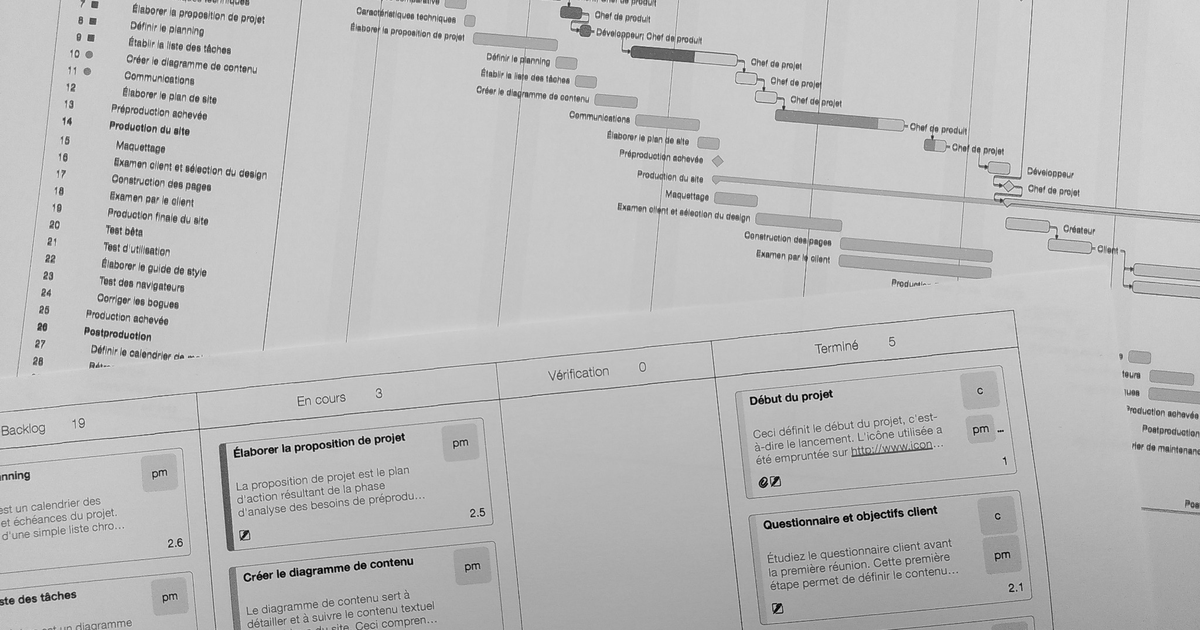How can you successfully estimate time and costs?

The challenge of each estimate is to identify the most realistic value possible, so that at the end of the project, the difference between the estimated value and the actual value is as small as possible. To get as close as possible to this realistic value, I use the following approach: The pi-figure method The […]
5 steps to choosing the right deadline management tool

One of the keys to successful projects is controlling deadlines. This requires good planning and coordination of the work needed to deliver the final results expected at the end of the project. Here are the 5 steps I use to keep my project deadlines under control.
What is the difference between the requirements specification and the product backlog?

The purpose of the specifications and the product backlog is to ensure that the final deliverable meets the needs of the customer or end user as closely as possible. It is therefore used to identify customer requirements and to structure the work to be done to achieve the final deliverable. So it’s the same thing, […]
From engineering to organisational intelligence: The journey of Prefix’s founder

From a technical world to a facilitative posture In the early years of my career, everything followed a fairly linear path: a degree in microengineering from EPFL, technical roles in Switzerland and Australia, spanning research and product development. It was solid, stimulating, coherent… but incomplete. Upon returning to Switzerland, a shift began. Joining a consultancy […]
SOLAR IMPULSE
CONTEXT Solar Impulse was founded in 2004 with the ambition to realise the first round-the-world flight with an airplane propulsed with solar power only. The project took place in two phases. The first phase consisted in the realization of the Solar Impulse 1 airplane that proved to possibility to fly a 24h cycle using only […]
STATE OF NEUCHÂTEL
CONTEXT The administration of the canton of Neuchâtel represents more than 4’500 people, organized in 5 departments and the chancellery, the 3 government bodies and 3 supervisory authorities. ACHIEVEMENTS Vincent Huguenin-Dumittan, Head of the Cantonal Public Health Department In a complex environment and with the need to find operational and agile solutions to an increasingly […]
COLIBRYS / SAFRAN
CONTEXT Colibrys was founded in 2001 as a spin-off of the Swiss Center for Electronics and Microtechnology (CSEM), specializing in the manufacture of high-precision sensors. In 2013, the company moved its infrastructure to a new site and was integrated into the Safran Group. In 2022, Colibrys became Safran Sensing Technologies Switzerland. Moving a production site […]
F. BAUD & T. FRÜH SA ATELIER D’ARCHITECTURE
CONTEXT F. Baud & T. Früh Atelier d’architecture, created in 1990, is composed of a dozen people and has acquired, among other things, a strong experience in the integration of environmental, social and economic constraints in their projects and in the energy efficiency of buildings. The founders of the office first decided to consolidate the […]
TOUR DE ROMANDIE – NEUCHÂTEL
CONTEXT The Tour de Romandie is a Swiss cycling stage race founded in 1947 that is considered as an ideal preparation for the Giro d’Italia and the Tour de France that take place later on. The city of Neuchâtel hosted stages of the Tour de Romandie three times: On each of these occasions, the city […]
ID QUANTIQUE
CONTEXT ID Quantique is an international company that uses light to develop and industrialise advanced quantum products and technologies for organisations to ensure long-term data protection and public safety. The company has established itself as a world leader in the fields of quantum security cryptography, scientific instrumentation and random number generation. Its products are used […]
CELGENE / BMS
CONTEXT Celgene Corporation is a pharmaceutical company that makes cancer and immunology drugs. The company has its headquarters in the USA and is a subsidiary of Bristol Myers Squibb. In 2015, the company decided to build a new manufacturing site in a valley of the Canton Neuchâtel in Switzerland, called Val-de-Travers. At this occasion and […]
H55
CONTEXT H55 is a Swiss company created in 2017 which mission is to bring tailored electric propulsion solutions to the aviation and VTOL industry. ACHIEVEMENTS All references
